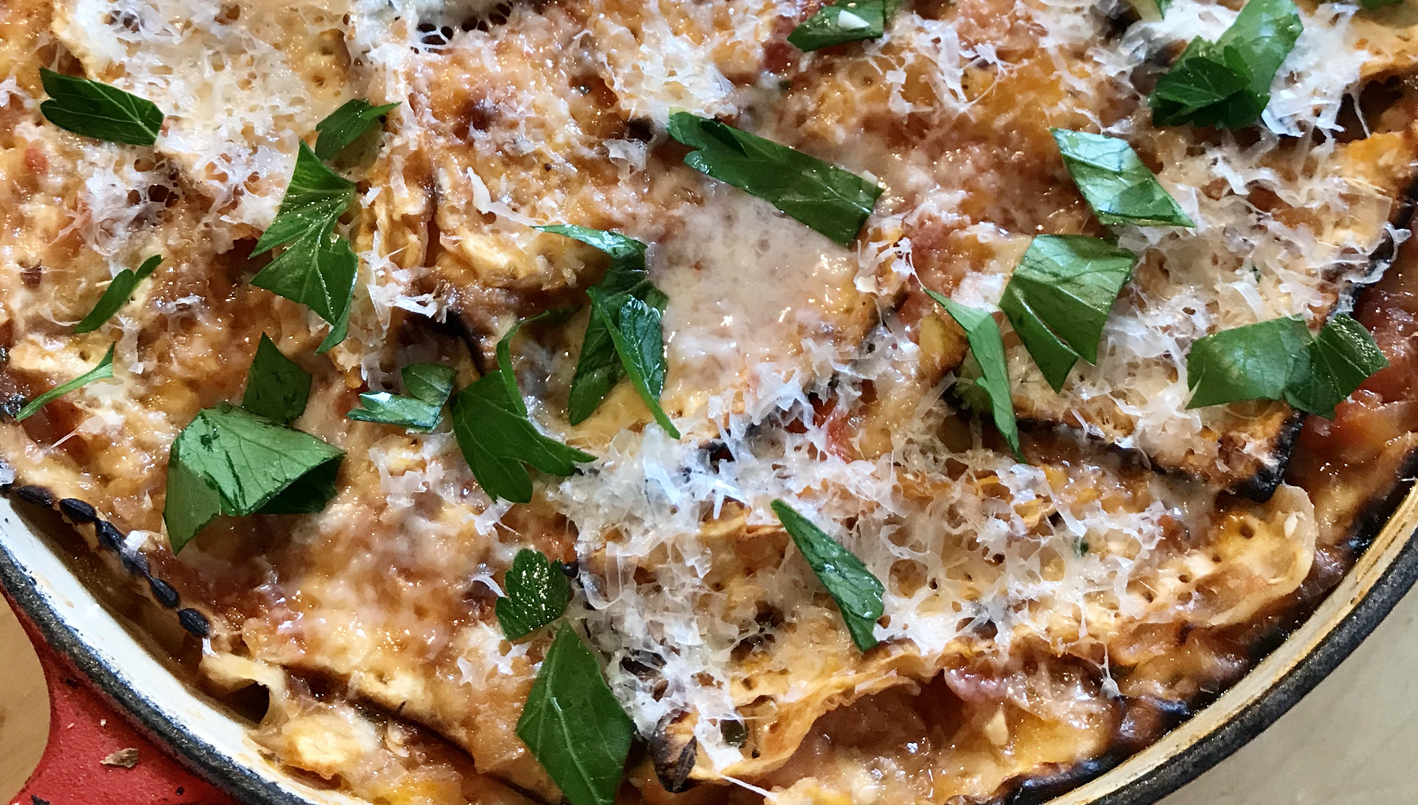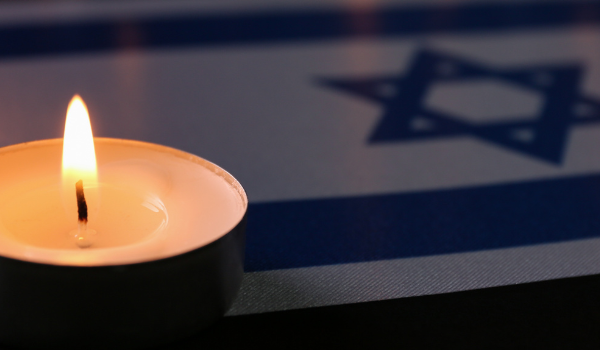How do you plan a ritual meal when you don’t want to leave the house? What if you don’t have the makings for a traditional meal? Alumni Kristin Posner (SF, founder of Nourish Co.), Dylan Maysick (CHI, founder of Diaspora Dinners), and Jeffrey Eisner (NYC, author of The Step-by-Step Instant Pot Cookbook) each shared a quarantine ready dish to get you in the spirit of Passover and help you plan your meal.
Jump to recipe:
Savory Potato Kugel with Preserved Lemon (Kristin Posner, San Francisco Feb. 2017)
Ribollita with Matzo (Dylan Maysick, Chicago July 2018)
Jewish Brisket (Jeffrey Eisner, NYC Feb. 2018-B)
Savory Potato Kugel with Preserved Lemon
Recipe by Kristin Posner

Kristin Eriko Posner (SF4) is the founder of Nourish Co., a lifestyle brand that helps multiethnic people and households create nourishing new rituals, drawn from time-honored traditions. She does this through writing personal essays, recipe development, and new modern heirlooms shop.
I’m a savory person through and through. This potato kugel is bright in flavor (and presentation) with the addition of preserved lemons mixed in, and topped with fresh herbs and lemon zest. Perhaps my favorite part is that it makes a great breakfast during the week of Passover. It’s also delicious re-heated and topped with a runny egg.
*This recipe was originally created for 18Doors*
Makes: About 15 squares
Total Prep Time: 30 minutes
Total Cook Time: 75 minutes
Ingredients:
- 2 medium yellow onions, cut into eighths
- 3 pounds Russet potatoes, peeled
- 1/3 cup potato starch
- 1 teaspoons kosher salt
- Freshly ground black pepper
- 3 large eggs, beaten
- 1/2 a preserved lemon, chopped
- 2 tablespoons olive oil
- Zest of 1/2 a lemon
- 4 sprigs of dill, chopped
- Handful of chives, chopped
- 1 tablespoon everything bagel seasoning
Tools:
- Food processor
- Cheesecloth or dish towel
- Pastry brush
- Baking dish
Instructions:
- Heat oven to 350°F.
- Using a food processor with a regular blade, pulse the onions a few times until they are chopped into smaller pieces (but not totally ground). Place onions in a large mixing bowl.
- Switch out the blade to the grating blade. For the best presentation, lay the potatoes on their sides (the long way) and shred. Empty out the food processor a couple of times into a large mixing bowl.
- Place the baking dish in the oven with 1 tablespoon olive oil.
- Place the onion and potato mixture in a cheese cloth and squeeze liquid out.
- Sprinkle the onion and potato mixture with salt, pepper, and potato starch. Toss everything together with your hands.
- Add the eggs and preserved lemon and mix again with your hands.
- Remove the dish from the oven and distribute the oil evenly on the bottom of the dish, in the corners and on the sides.
- Pour the potato mixture into the pan slowly and be careful, since it will splatter a bit. Using your fingers, gently twist the potato shreds evenly to create a nice texture on the top of the dish. Brush with remaining tablespoon of oil.
- Bake for 60 minutes. Check on the kugel — if it’s browning unevenly turn the dish around to bake for another 15 minutes. At this point, check to see if the center is baked and the top is browned.
- Sprinkle with dill, chives, zest, and everything bagel seasoning. Cut into squares and serve. You can make it ahead and reheat it in the oven. It should keep in the fridge for a week and longer in the freezer. This kugel makes an excellent breakfast, topped with a poached or soft-cooked egg!
Ribollita with Matzo
Recipe by Dylan Maysick

Dylan Maysick is the cofounder of the Chicago-based culinary project Diaspora Dinners, an ever-changing series of dinners, workshops, catered events, and cookbooks that explore the cuisines and cultures of the Jewish Diaspora.
In Italian, “ribollita” means “reboiled.” The origin of the dish comes from servants who would save the remnants of great banquets and reheat them to cobble together a meal of their own. This practice often involved a substantial amount of stale bread, which this recipe swaps out for crunchy matzo. While so many Passover recipes strive to overcome the very nature of matzo and turn it into something else completely, ribollita requires a crunchy, ideally stale bread product in the first place, making matzo a natural choice.
Serves 4 to 6
Time: about 1 hour to 2 hours
Active work: About 25 minutes
Ingredients
- About 1/4 cup extra-virgin olive oil, divided
- 1 medium onion, diced
- 3 medium carrots, peeled and diced
- 1 celery stalk, very thinly sliced
- 6 cloves to 1 head garlic (Ask yourself, how much do I like garlic? Then plan accordingly.)
- 28-oz. can diced tomatoes
- 1 15.5 oz. can Cannellini beans, or about heaping 1/2 cup dried beans
- 1 wedge Parmigiano Reggiano
- 1 sprig thyme
- 1 sprig rosemary
- 1 heaping tablespoon chopped fresh parsley, divided
- 1 bunch Tuscan kale, stemmed and roughly chopped
- Kosher salt, to taste
- Freshly cracked black pepper
- Crushed red pepper, about 1/4 teaspoon
- About 2 square matzos, or 1 piece round shmura matzah
Directions
- If using dried beans, begin by soaking them. An overnight soak is ideal.
- Place a Dutch oven or other heavy duty pot over low heat and add a splash of olive oil – just enough to lightly coat the bottom. Peel and dice the onion, and add it to the pot. Peel and dice the carrots, add them to the pot, followed by the celery, stirring occasionally. Cook the mixture down until it’s fragrant and lightly browned, about 10 to 12 minutes. Mince the garlic and mix it in, cooking until fragrant, no more than a minute or so.
- Add the tomatoes, followed by the beans. Cut off the rind of the parmesan, leaving a little bit of cheese attached, and add it to the pot. If beans are not submerged, add enough water to cover them. Bring the mixture to a boil, then drop it to a simmer. Add the thyme, rosemary, and half the parsley.
- Next, chop the kale, adding it a little bit at a time. Grate in a few tablespoons of parmesan, stirring it into the mix. Add a little salt, taste, and add more until well seasoned. Add as much black pepper as you like, along with crushed red pepper.
- Preheat the oven to 450°F and let the mixture simmer until beans and kale are tender, at least 20 minutes and maybe more as needed.
- Once beans and kale are tender, break up one sheet of matzo and stir it in to the mixture, break up another and place the pieces on the surface, gently pushing them just below the surface so that they soak. Bake until the stew thickens and the matzo cooks a bit – about 10 minutes.
- Garnish with a generous pile of grated parmesan, a splash of olive oil, and the remaining parsley. Serve immediately.
Jewish Brisket
Recipe by Jeffrey Eisner

Jeffrey Eisner is the creator of Pressure Luck Cooking, an acclaimed, easy-to-follow Instant Pot recipe video blog. Featured on the Food Network, Good Morning America,and Rachael Ray, he creates his famously flavorful recipes at home in Queens, New York. In addition to having participated in HMI NYC Trip 7B with his partner, Richard, he also led trips 8 and 10B. He loves to cook, eat and make people laugh.
- Flat-cut Brisket (usually about 4-7 lbs). Trim off some of the fat and rub Kosher salt on both sides of the brisket
- 4 large Spanish or yellow onions, roughly chopped
- 3/4 cup white vinegar
- 1 1/2 cups water
- 1 1/2 cups ketchup
- 3/4 cup brown sugar (light or dark, though dark is preferred for color)
- 3 cloves (1 tablespoon) garlic, crushed or minced
- Bring a dry frying pan to high heat on the stove. Place the brisket in the hot pan and sear (about 3-5 mins) then turn over and do the same thing to other side. (If you have a huge piece of brisket that doesn’t fit the frying pan, you can slice it in half and do this in batches)
- Transfer the seared brisket in disposable baking tin tray or casserole dish.
- Cover brisket with the onions, filling in the space around it with any remaining onions.
- Mix the vinegar, ketchup, water, brown sugar and garlic in a bowl.
- Pour the mixture over meat and onions.
- Cover the baking tin or casserole dish tightly with double layers of foil. Put the baking tin on a cookie sheet to catch drippings (plus it will be easier to remove when done).
- Bake on 375° for 2 1/2 hours the day before you want to serve this dish. You can even do this 2 days before.
- When done, allow to cool for 20-30 minutes and then slice the meat against the grain. Return the meat to the baking dish to be covered in the juices and re-cover with double layers of foil.
- Refrigerate overnight. But feel free to also snack on a piece before you do. It’ll be mouth-watering.
- On the day of serving, bake, covered with foil, on 350° another 1 1-1/2 hours and serve.




